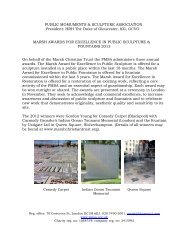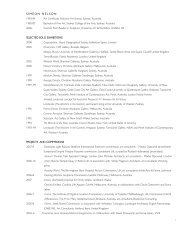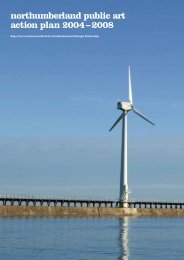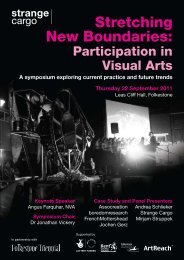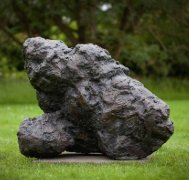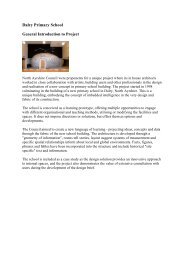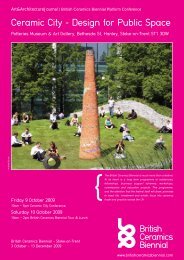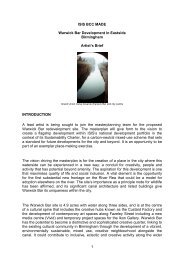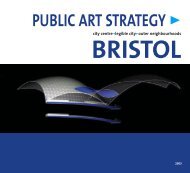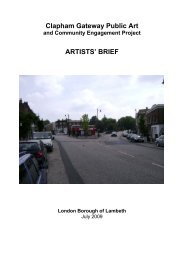Download the Brochure including maps for ... - Public Art Online
Download the Brochure including maps for ... - Public Art Online
Download the Brochure including maps for ... - Public Art Online
You also want an ePaper? Increase the reach of your titles
YUMPU automatically turns print PDFs into web optimized ePapers that Google loves.
www.stridingarches.com<br />
www.stridingarches.com
I would hope that collectively <strong>the</strong>se arches<br />
are a celebration and monument to <strong>the</strong><br />
Scottish people and <strong>the</strong> travels <strong>the</strong>y have<br />
made, and that <strong>the</strong>y will act as a connection<br />
between those who have left and those who<br />
have stayed here.<br />
Andy Goldsworthy<br />
Andy Goldsworthy is one of <strong>the</strong> world’s <strong>for</strong>emost artists working directly in <strong>the</strong><br />
landscape. Striding Arches – a series of grand, self-supporting arches standing on hilltops<br />
surrounding <strong>the</strong> natural amphi<strong>the</strong>atre at Cairnhead – is <strong>the</strong> first of Goldsworthy’s large-scale<br />
projects involving multiple structures to be installed in a public landscape in Scotland.<br />
O<strong>the</strong>r arches made of Dumfriesshire sandstone by Goldsworthy stand in Canada, <strong>the</strong> United<br />
States and New Zealand, echoing <strong>the</strong> travels of emigrating Scots over <strong>the</strong> last 200 years or so,<br />
and of <strong>the</strong> sandstone carried as ballast by timber ships making <strong>the</strong> return voyage to North<br />
America. ‘The stone is a potent symbol of <strong>the</strong> Scots who went abroad,’ says Goldsworthy, ‘of<br />
<strong>the</strong> tremendous upheaval <strong>the</strong>y made, or were <strong>for</strong>ced to make, when <strong>the</strong>y left Scotland… I<br />
would hope that collectively <strong>the</strong>se arches are a celebration and monument to <strong>the</strong> Scottish<br />
people and <strong>the</strong> travels <strong>the</strong>y have made, and that <strong>the</strong>y will act as a connection between those<br />
who have left and those who have stayed here.’<br />
Each arch stands just under four metres high, with a span of about seven metres, and consists<br />
of 31 blocks of hand-dressed red sandstone weighing approximately 27 tons.<br />
Crucial to Goldsworthy’s selection of sites was his stipulation that no matter which arch<br />
you find yourself at, you should always be able to see <strong>the</strong> o<strong>the</strong>r two: <strong>the</strong> three arches are<br />
linked toge<strong>the</strong>r by sightlines. ‘What I am working is <strong>the</strong> space, <strong>the</strong> line, <strong>the</strong> stuff that is<br />
intangible, <strong>the</strong> atmosphere of <strong>the</strong> work, <strong>the</strong> feel of it, <strong>the</strong> bits in between. That <strong>for</strong> me is<br />
<strong>the</strong> work.’<br />
At Cairnhead steading, <strong>the</strong> first of <strong>the</strong> arches to be installed (in 2005) leaps from <strong>the</strong> gable<br />
end of a disused farm building, a striking demonstration of <strong>the</strong> impulse Goldsworthy<br />
associates with this <strong>for</strong>m: ‘I’ve always liked <strong>the</strong> idea of <strong>the</strong> free-roaming arch, released<br />
from <strong>the</strong> quarry, unconfined by a building.’<br />
The Byre – a combination of sculpture and shelter – provides a<br />
meeting point <strong>for</strong> visitors to <strong>the</strong> Striding Arches, as well as an easily<br />
accessible introduction to its partners on <strong>the</strong> hilltops. In <strong>the</strong> area<br />
around <strong>the</strong> Byre are various inscriptions on stone by lettercarver Pip<br />
Hall reflecting <strong>the</strong> human history of <strong>the</strong> place.<br />
The Striding Arches project has come out of <strong>the</strong> mutual ambitions<br />
of Andy Goldsworthy, Cairnhead Community Forest Trust and <strong>the</strong><br />
Dumfries & Galloway <strong>Art</strong>s Association to site a permanent work in a<br />
public landscape space in south-west Scotland, not far from where<br />
<strong>the</strong> artist has chosen to make his home.
Cairnhead is a beautiful and rewarding place to walk in. In time, it will become even richer.<br />
Explore / Hills<br />
Visiting <strong>the</strong> arches on <strong>the</strong> hill tops can be challenging, and you will need to be prepared <strong>for</strong> some fairly<br />
demanding walking, sometimes across open moorland. Cairnhead is a working <strong>for</strong>est landscape, and<br />
as <strong>the</strong> programme of harvesting proceeds, new <strong>for</strong>est tracks will be constructed, eventually <strong>for</strong>ming a<br />
comprehensive network of straight<strong>for</strong>ward routes up on to <strong>the</strong> hills and <strong>the</strong> arches. Meanwhile, you are free<br />
to explore anywhere within <strong>the</strong> <strong>for</strong>ests owned by Forestry Commission Scotland.<br />
You should have with you <strong>the</strong> Explorer map OS 328 (2 1 / 2 inch to <strong>the</strong> mile). Cairnhead is 11 km / 7 miles<br />
from Moniaive.<br />
The nearest hill-top Striding Arch from here is on Colt Hill. At 9 km or nearly 6 miles in total, this is a<br />
strenuous walk requiring waterproof footwear. Follow <strong>the</strong> <strong>for</strong>est road 4 km / 2 1 / 2 miles up <strong>the</strong> glen<br />
and near <strong>the</strong> top, turn right off <strong>the</strong> track at <strong>the</strong> finger post. Continue <strong>for</strong> 1 / 2 km / 1 / 3 mile along <strong>the</strong><br />
edge of <strong>the</strong> <strong>for</strong>estry to <strong>the</strong> arch on top of Colt Hill. To return, retrace your steps.<br />
A 14 km / 9 mile walk will take you to <strong>the</strong> Striding Arch on Benbrack (hill-walking boots<br />
recommended). Follow <strong>the</strong> <strong>for</strong>est road up <strong>the</strong> glen <strong>for</strong> 4 km / 2 1 / 2 miles and, near <strong>the</strong> top, at <strong>the</strong><br />
finger post, turn left off <strong>the</strong> track. Continue <strong>for</strong> about 200 metres along <strong>the</strong> edge of <strong>the</strong> plantation,<br />
<strong>the</strong>n turn left along <strong>the</strong> Sou<strong>the</strong>rn Upland Way <strong>for</strong> approximately 3 km / 2 miles to <strong>the</strong> arch on top of<br />
Benbrack Hill. To return, retrace your steps.<br />
At present <strong>the</strong>re are no defined <strong>for</strong>est roads or paths leading to <strong>the</strong> Striding Arch on Bail Hill, so you<br />
need to be prepared to find your own way, with <strong>the</strong> help of map and compass.<br />
Should you wish to follow in <strong>the</strong> steps of Andy Goldsworthy – from one hill-top arch to <strong>the</strong> next<br />
around <strong>the</strong> perimeter of <strong>the</strong> glen – you should be prepared <strong>for</strong> rugged conditions and a challenging<br />
hike of roughly 16 km / 10 miles over hilly terrain, again armed with a map and compass: <strong>the</strong> route<br />
will be created gradually by those who walk it.<br />
The plantations at Cairnhead are mainly of Sitka spruce, established <strong>for</strong> timber production. In common<br />
with o<strong>the</strong>r <strong>for</strong>ests in Dumfries & Galloway, Cairnhead has proved a welcome refuge <strong>for</strong> red squirrels whose<br />
numbers have actually increased in this area. Small birds such as <strong>the</strong> coal tit, siskin and crossbill all make <strong>the</strong>ir<br />
homes here and are relatively easy to see. Red deer and roe deer roam through <strong>the</strong> <strong>for</strong>est, and birds more<br />
usually seen in deciduous woodland, <strong>including</strong> song thrushes, goldcrests and chaffinches, frequent areas of<br />
mature trees.<br />
The clear waters of Dalwhat Water and <strong>the</strong> numerous small burns and ditches feeding it from <strong>the</strong> hills<br />
support an enormous variety of insect life. Keep a look out, in summer, <strong>for</strong> damselflies and <strong>the</strong> goldenringed<br />
dragonfly, mayflies and caddis flies. Dalwhat Water itself provides an important nursery habitat <strong>for</strong><br />
Atlantic salmon: after <strong>the</strong> eggs laid in gravel nests here have hatched, juvenile salmon remain in <strong>the</strong> burn <strong>for</strong><br />
two to three years be<strong>for</strong>e migrating to sea.<br />
Several birds of prey have increased significantly in number around Cairnhead: goshawks, which are swift<br />
and agile flyers, navigate <strong>the</strong>ir way ef<strong>for</strong>tlessly into areas of mature trees in <strong>the</strong> <strong>for</strong>est, <strong>the</strong> more remote<br />
<strong>the</strong> better; short-eared owls prefer <strong>the</strong> young plantations, where <strong>the</strong>y can nest and raise <strong>the</strong>ir young on <strong>the</strong><br />
ground, and easily move in and out of <strong>the</strong> cover af<strong>for</strong>ded by trees; and barn owls, which hunt over meadow<br />
and grassland, are drawn to <strong>the</strong> valley bottoms where <strong>the</strong>y nest in abandoned farm buildings and bothies.<br />
Birds associated with open scrub such as whinchats, stonechats and meadow pipits make use of <strong>the</strong> open<br />
areas on <strong>the</strong> hilltops above <strong>the</strong> <strong>for</strong>est, whilst ravens nest on craggy outcrops and soar above <strong>the</strong> glen.<br />
The ongoing Forest Design Plan <strong>for</strong> felling and restocking Cairnhead will link and enlarge remaining<br />
fragments of mixed native woodland using <strong>the</strong> corridor network of <strong>the</strong> burns here. In time, more diverse<br />
habitats will develop and a greater range of species will repopulate <strong>the</strong> glen, from Scotch Argus butterflies<br />
to nightjars and black grouse.<br />
Images by Mike Bolam, wildlife images by Scottish Natural Heritage. Design by weesleekit ltd<br />
Bail Hill arch Colt Hill arch Benbrack arch The Byre The Byre Letter carving by Pip Hall, Cairnhead Alec Finlay letterbox, Cairnhead Buzzard Scotch Argus butterfly





